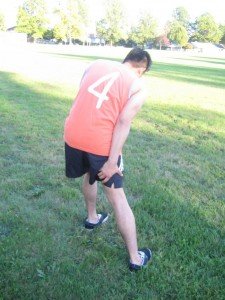A pulled hamstring is an injury that occurs when the hamstring, a group of large muscles at the back of the thigh, is overstretched to the point that it starts to tear or in more severe cases, has completely tore off. The hamstring muscle is composed of three muscles – the semitendinosus, semimembranosus and biceps femoris muscles – that arise from the lower hipbone and connect to the tibia and fibula, which are the upper parts of the lower leg bone. These muscles are primarily involved in the flexion of the knee and the extension of the leg straight back.
A pulled hamstring often occurs when the muscle is overstretched beyond its limits or when a sudden heavy load is exerted on to the muscle causing the strain. A sprinting induced hamstring strain often occurs at the lower end of the muscle, nearer to the knee, as the back leg is stretched and straightened in order to propel the body forward. At this point, the body weight of the person pushing down on the stretched muscle can apply enough pressure for it to produce a muscle strain. If heavier loads are applied, a hamstring tendon avulsion, or when the tendon completely detaches from the bone, may occur. Overstretching related injuries, on the other hand, occur higher in the muscle, nearer to the hip, and may take longer to heal. This is often seen in activities such as gymnastics, dancing or martial arts.
Symptoms of a Pulled Hamstring
The first symptom of a pulled hamstring often is an acute and sharp pain at the back of the thigh. This will limit the weight bearing capacity of the muscle forcing you to stop. Other symptoms are the following:
- Popping or tearing sensation at the back of the thigh upon sprinting or doing fast stretching movements such as kicking
- Swelling, tenderness and bruising at the back of the thigh a few hours after the injury
- Muscle weakness and diminished weight bearing capacity of the muscle that persists for weeks

Grading of a Pulled Hamstring
Grading of a pulled hamstring depends on the severity of the injury. The following grading is as follows:
- Grade 1: Mild muscle strain
- Grade 2: Partial muscle tear
- Grade 3: Complete muscle tear
Treatment of a Pulled Hamstring
Recovering from a pulled hamstring depends on the severity of the injury. A grade 1 pulled hamstring can heal in a few days while a grade 3 pulled hamstring will entail months of rehabilitation. The following can be done as first aid:
- Rest – Avoid any activity that may incite pain and immobilize the leg as much as possible. Crutches may be needed.
- Ice – Ice the hamstring muscle several times a day for at least 10 minutes
- Compression – Compression bandage can reduce the swelling in the area
- Elevation – Elevating the leg while sitting or lying down can ease the swelling
- Non-steroidal Anti-inflammatory drugs such as ibuprofen and aspirin to relieve the pain
Once the initial pain and swelling has subsided, physical therapy may be done to restore range of motion, flexibility and strength of the muscle. In more severe cases, surgery may be needed to repair the torn off tendon by reattaching it to the bone.
A hamstring strain, or otherwise known as a pulled hamstring, is a painful injury of the muscles at the back of the thigh that commonly affects athletes engaged in sports that involve a lot of sprinting, sudden stopping and stretching of the legs.
